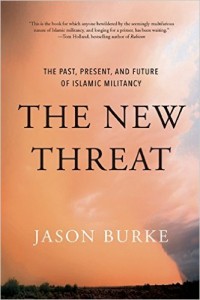Book Review: “The New Threat” (Jason Burke)
Posted on: in Politics by .
Tags: book review, islamism, Politics

I have a mild addiction to 24 hour rolling news, so this year I’m instead trying to channel that interest into reading good non-fiction books on history and politics. I started with Jason Burke’s latest book “The New Threat From Islamic Militancy”, which gives a history and analysis of violent Islamism. Burke himself is a veteran Guardian correspondent, and his previous books have received rave reviews from critics with quite different politics (The Economist and Noam Chomsky are both big fans). In this work, he is concerned with analyzing the threat violent Islamism poses to the West, though he recognizes and repeatedly acknowledges that the overwhelming majority of its victims are in the Middle East and Central Asia.
I found the book extremely thoughtful, engagingly and clearly written, and very rich in content, so I can highly recommend it. Here are three of the main things I took from the book.
- The previous generation of violent Islamists and the perpetrators of Al Qaeda attacks (including the 9/11 hijackers) tended to be from middle class families, fairly well educated, and well versed in specific extremist literature (notably the work of Sayyid Qutb and Abdullah Yusuf Azzam). More recent Islamist terrorists, by contrast, have tended to be younger, poorer, and less educated, and frequently possessed of a criminal past involving drugs and violence. They are likely to have been radicalized either in prison or by friends and family members (Burke decries the idea of the “lone wolf” as a myth), and to have very little interest in or understanding of the theoretical background of Islamism.
- Radical Islamism was, on the whole, in decline, both in terms of popularity and effectiveness, from 2005-2011. Al Qaeda suffered materially due to the loss of Afghanistan as a safe and stable base of operations, and generated widespread revulsion throughout the Middle East via acts of violence against ordinary Muslims in Iraq and Jordan (especially the 2005 bombings in Amman). However, the Arab Spring, though not initiated by Islamists, nonetheless served to revitalize and galvanize the broader movement. The failures of governance and the attendant political instability and violence throughout the region has created more regional support for violent Islamism and created new fairly stable bases of organization and operation in Yemen, Syria, Libya, and Iraq.
- The biggest long threat to the West identified by Burke comes from a broader breakdown in relations with the Muslim world. The figures on attitudes towards the West in the Muslim world make for bleak reading. Although the proportion of Westerners who hold broadly favorable attitudes towards Muslims has remained steady, at around two-thirds, the same is not true in dominantly Muslims countries. Since 2003, for example, the percentage of Turkish Muslims who hold generally favorable attitudes towards the West has gone from 31% to just 6%. Similar trends are present in predominantly Muslim countries in the Middle East and Central and South Asia. There are lots of reasons for this decline, but Burke focuses on the threat it poses to all of us, and specifically the worry that the ‘clash of civilizations’ narrative propagated by radicals and xenophobes in both the West and the Muslim world is being made more probable. Both Al Qaeda and ISIS have talked about the “gray zone” of conservative Muslims around the world who have strict values and who are unhappy with the West’s political actions but repudiate violence and extremism. A key goal of both organizations is to collapse this gray zone, and force these Muslims to make a choice between conflict with the West and betraying their coreligionists. Burke rightly argues that maintaining the gray zone, and preserving tolerance and concord (if not always ideological agreement) between Muslims and non-Muslims is vital to the survival of civilization as we know it.
This is just a crude summary of some of the book’s many excellent points. It makes excellent reading for anyone interested in understanding the origins and future of Islamic extremism, and the nature of the threat it poses to the West. You can find it here.
Leave a Reply